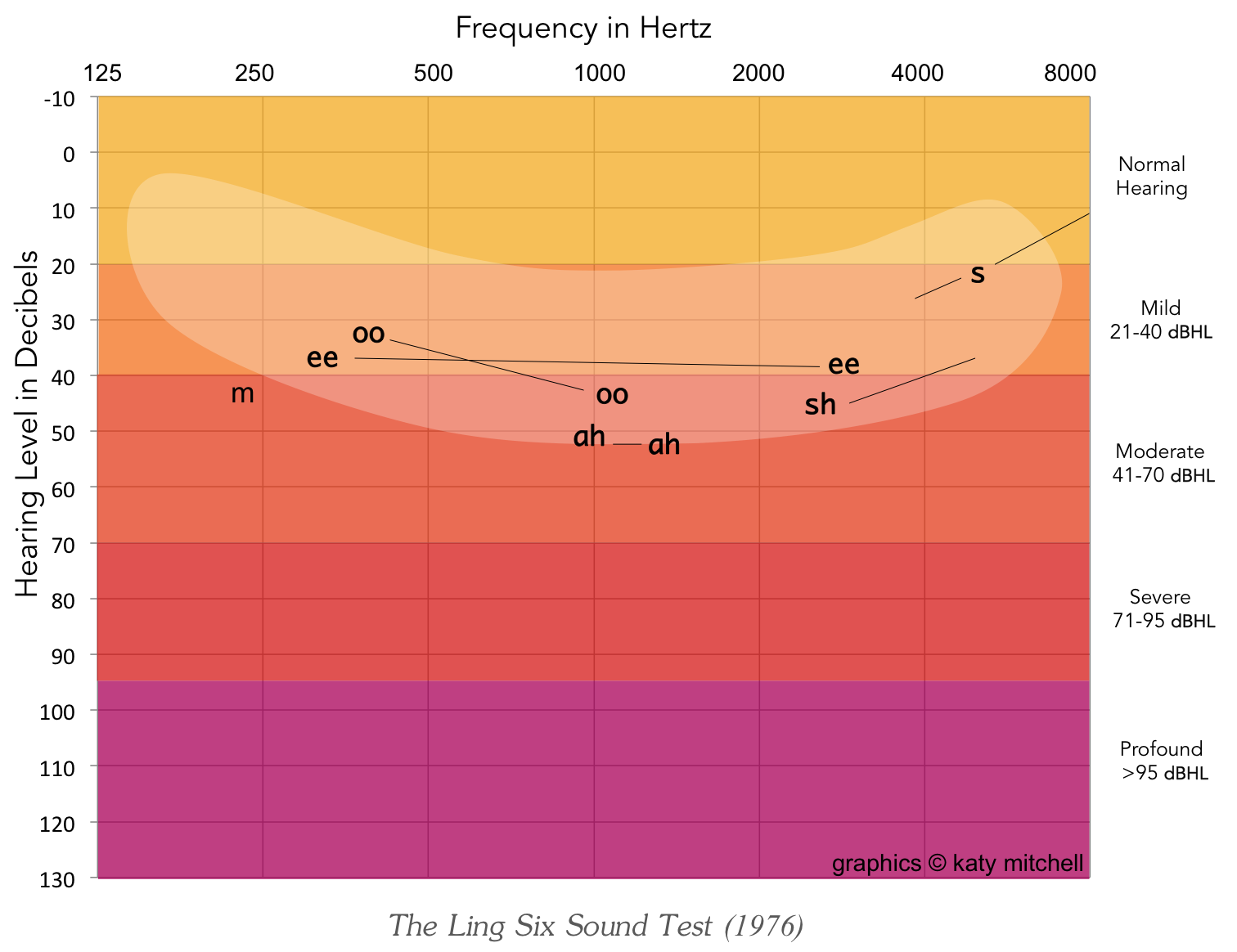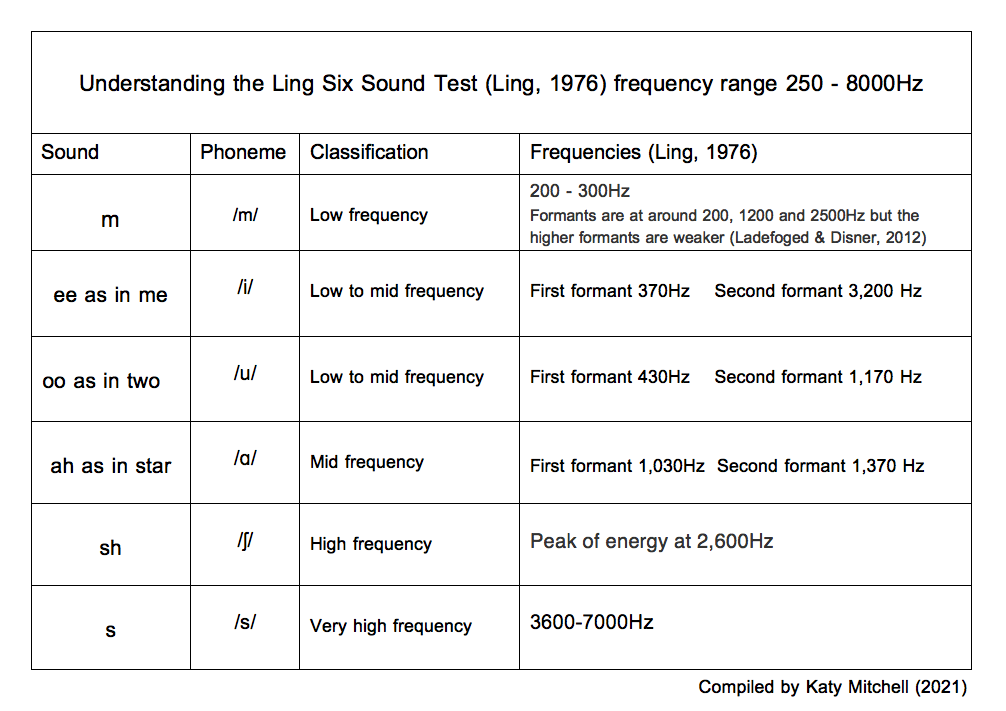Understanding Hearing Loss
|
|
Sounds of SpeechEach sound of speech can be described in terms of pitch (frequency) and loudness (intensity). An understanding of the acoustic properties of speech is important to understand the impact of hearing loss on speech access. Speech sounds vary in frequency. Accessing the consonants of speech is important and 70% of word recognition comes from sounds in the frequency range of 500 to 2000Hz (Northern & Downs 2002). Spoken language is acquired by hearing speech. It is heard, copied, practised and then perfected. A child needs to be able to hear the sounds of speech, which are in the frequency range of 250 Hz to 8000Hz (Cole & Felxer, 2011) to be able to produce them. A child needs to receive good auditory feedback of their own voice to monitor the production of their speech and change it accordingly.
The sounds of speech can be plotted on an audiogram, a graph which shows loudness and pitch. This audiogram shows what is often referred to as the ‘speech banana’: a banana shaped area on the audiogram containing the frequencies and decibel levels needed to hear the sounds of speech. In spoken English, morphemes are used at the ends of words to make grammatical changes, altering the meaning of words. Plurals, possession and the third person (he eats) involve adding an ‘s’ to the end of the word. This high frequency sound will be very quiet (around 20dB). Similarly past tense markers (cries/cried) will be produced at a quiet level at the end of words. Appropriate amplification is needed to ensure that a child with a hearing loss can access these quiet differences in speech. The Consonantal Speech Banana (Keen 2014) shows how the loudness of a sound changes depending on its position within a word. When speech is presented at a distance and in noise, clarity will be further compromised. If a child is unable to hear the sounds of speech clearly this will have an impact on the development of both their receptive and expressive language.
The Ling Six Sound Test The Ling Six Sound Test (Ling,1976) consists of phonemes of speech mm, ah, ee, oo, s and sh, that cover the speech frequency range 250-8000Hz and can be used to show if low, mid and high frequency speech sounds can be detected by requesting or observing a response to the production of the sounds. Children can be taught an association between the sound and an object or picture. For example, a toy snake or the action of pretending to be a snake, could be used to model the 's' sound.
When a child is familiar with the sounds and can repeat them, the Ling Six Sound Test can be used as a quick daily amplification check, as shown in this video. Advanced Bionics includes a 'Ling Six Sound Check' in the Tools for Toddlers resource.
The frequencies of the sounds of speech will be different for a man, woman and child. The different pitches at which air vibrates in the vocal tracts are called formants and these change as the size and shape of the vocal tract changes. Formants are concentrations of sound energy. As a speech sound is made up of different formants a sound can cover a wide frequency range. The Ling Six Sound Test (1976) includes sounds that cover the frequency range 250Hz to 8000Hz as shown in the audiogram and table above.
The McCormick Toy Test
The McCormick Toy Test was developed in 1977 by Professor Barry McCormick and consists of 7 pairs of words with the same vowel sound and different consonants. It is important to know if the child understands the vocabulary, so any unknown words are not used. A child is asked using a quiet voice to choose the correct toy and passes the test with four out of five correct responses. The test is child friendly and easy to administer (McCormick, 2004). The automated McCormick Toy Test is used in children’s audiology departments providing useful information about access to the sounds of speech.
References Advanced Bionics (2015) Tools for Schools, Audiogram of familiar sounds [Online] Available at: https://advancedbionics.com/us/en/home/support/tools-for-schools.html [Accessed: 14 February 2021]. Advanced Bionics (2016) Tools for Toddlers, The Ling Six Sound Check [Online] Available at: https://advancedbionics.com/content/dam/advancedbionics/Documents/libraries/Tools-for-Toddlers/Tools-for-Toddlers-Ling-Six-Sound-Check.pdf BATOD British Association of Teachers of the Deaf (2021) Ling 6 Video examples - Rwanda [Online] Available at: https://www.batod.org.uk/information/ling-6-video-examples-rwanda/ [Accessed: 20 February 2021]. Buckley, B. (2006) Children’s communication skills from birth to five years. Oxford: Routledge. Cole, E. & Flexer, C. (2011) Children with hearing loss: Developing listening and talking. (Second edition). San Diego, CA: Plural Publishing Inc. Keen, P (2014) New Consonantal Speech Banana Ladefoged, P. & Disner, S.F. (2012) Consonants and Vowels, Third Edition. Wiley-Blackwell Ling, D. (1976) Speech and the hearing-impaired child: Theory and practice. Washington, DC: Alexander Graham Bell Association for the Deaf. McCormick, B. (1977) ‘The toy discrimination test: An aid for screening the hearing of children above a mental age of two years’. Public Health. Volume 91, Issue 2, March pp.67-74 McCormick, B (2004) Paediatric Audiology 0-5 years. 3rd ed. London, Whurr MED-EL Ling Six Sound Cards [Online] Available at: https://www.medel.com/en-gb/support/rehab/rehabilitation-downloads [Accessed: 20 February 2021]. Meuller& Killion (2010) A New Count-The-Dots Method. The Hearing Journal January 2010 Vol. 63 No 1 Northern, J.& Downs, M. (2002) Hearing in Children (5th Edition). Baltimore, MD:Williams and Wilkins Co. |




 For very young children the sounds can be associated with toys as shown in the photograph. Children aged between 18-24 months may be able to understand a representation in a simple colour photograph (Buckley, 2006) and at this age it will be possible to start to make associations between the sounds and pictures, such as the '
For very young children the sounds can be associated with toys as shown in the photograph. Children aged between 18-24 months may be able to understand a representation in a simple colour photograph (Buckley, 2006) and at this age it will be possible to start to make associations between the sounds and pictures, such as the '


